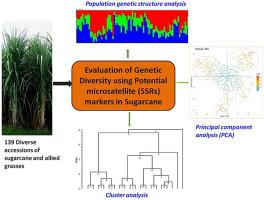Gene ( IF 3.5 ) Pub Date : 2020-05-23 , DOI: 10.1016/j.gene.2020.144800 Ram Baran Singh 1 , Mahesh D Mahenderakar 2 , Arun K Jugran 3 , Ram Kushal Singh 4 , Rakesh K Srivastava 2

|
Sugarcane is one among the most important commercial crops used to produce sugar, ethanol, and other byproducts, which significantly contributes in the GDP of India and many other countries around the world. Genetic diversity is a platform for any breeding program of a plant species. Estimation of the genetic variability and population structure play a vital role for conservation planning and management of plant genetic resources. Genetic variability serves as a source of noble alleles responsible for key agronomic and quality traits, which ultimately form basis for identification and selection of promising parents for breeding programs. In the present study genetic diversity and population structure of 139 accessions of the genus Saccharum, allied genera of family Poaceae and cultivars were assessed using informative microsatellite (SSR) markers. A sum of 427 alleles was produced using 61 polymorphic primers and number of alleles generated was ranged from 2 to 13 with an average of 7 alleles per locus. PIC values were ranged from 0.35 to 0.90, with a mean value of 0.66 for all the markers evaluated. Cluster analysis based on UPGMA method revealed three major clusters which were further subdivided into nine subclusters. Population structure analysis also established three subpopulations of used accession set, however there were no correlation of sub-groupings with that of place of origin. AMOVA analysis also confirmed that 83% and 17% of total variations were attributed to the within- and between-populations, correspondingly, demonstrating greater exchange of gene pool across places of origin. The principal component analysis (PCA) demonstrated the distribution of accessions in the scatter-plot was substantially dispersed, revealing rich genetic diversity among accessions of different species. The findings from this study will be useful in breeding programs for introgression of noble alleles into modern cultivars by exploiting natural genetic variation existing in sugarcane genetic resources.
中文翻译:

使用微卫星(SSR)标记评估甘蔗品种,祖先物种和属的遗传多样性和种群结构。
甘蔗是用于生产糖,乙醇和其他副产品的最重要的商业作物之一,对印度和世界其他许多国家的GDP都有重要贡献。遗传多样性是任何植物物种育种计划的平台。遗传变异性和种群结构的估计对于植物遗传资源的保护规划和管理起着至关重要的作用。遗传变异是负责关键农艺和品质性状的高等位基因的来源,这些最终成为鉴定和选择育种计划中有希望的亲本的基础。在本研究中遗传多样性和属139个种质群体结构甘蔗,家族联盟属禾本科使用信息性微卫星(SSR)标记评估品种。使用61个多态性引物产生了427个等位基因,并且产生的等位基因数量为2至13,每个位点平均7个等位基因。PIC值的范围为0.35至0.90,所有评估的标记物的平均值为0.66。基于UPGMA方法的聚类分析显示出三个主要的聚类,这些聚类又细分为9个子类。人口结构分析还建立了使用过的登录集的三个亚群,但是这些亚群与原产地之间没有相关性。AMOVA分析还证实,总变异的83%和17%归因于种群内部和种群之间,这相应地表明了跨来源地的基因库交换更多。主成分分析(PCA)表明,散点图中种质的分布基本分散,揭示了不同物种种质之间丰富的遗传多样性。通过利用甘蔗遗传资源中存在的自然遗传变异,这项研究的发现将有助于将贵族等位基因渗入现代品种的育种计划。



























 京公网安备 11010802027423号
京公网安备 11010802027423号